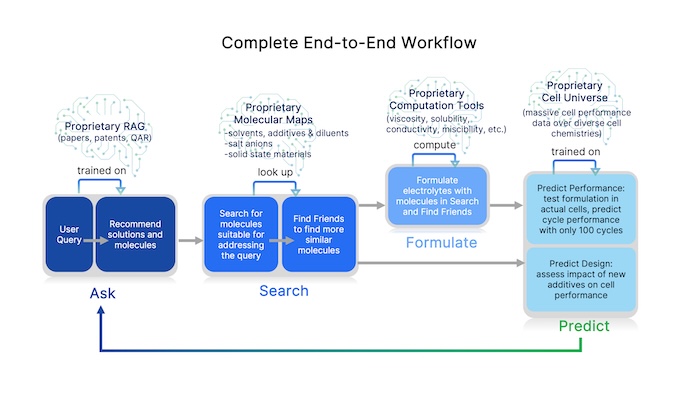SES AI Enhances Leadership of Material Discovery in Battery Industry with Newest Version of Molecular Universe and Enterprise-Level Subscription Offerings
SES AI Corporation (“SES AI”, the “Company,” “we” or “us”) (NYSE: SES), a global leader in the development and manufacturing of AI-enhanced high-performance Li-Metal and Li-ion batteries, announced at The Battery Show – North America that the Company will be unveiling Molecular Universe 1.0 (MU-1) on October 20, 2025, its latest and most complete battery material discovery software and service platform. The Company also announced that, due to the popularity of the Enterprise tier, it has expanded its subscription offerings and hired a new business development lead to accelerate its go-to-market strategy in the battery industry and adjacent molecule-dependent industries.

MU-1 provides complete end-to-end material discovery capability, including literature research and solution recommendation (“Ask”), molecule search (“Map” and “Search”), formulation search (“Formulate”), and cell performance prediction (“Predict”). MU-1 has the potential to accelerate battery material discovery from years to just tens of minutes. The following link can be used to sign up for the live demo launch of MU-1 on Monday, October 20, 2025.
MU-1 now offers three sub-tiers within Enterprise, providing greater service at greater value. Molecular Universe has already helped several Enterprise customers address their battery challenges, including:
- Energy Storage: improving low temperature cycle life of LiFePO4 Li-ion cells
- Drones & Robotics: improving safety and energy density of high content Silicon anode Li-ion cells
- EV: improving cycle life of low and medium content Silicon anode Li-ion cells
- Consumer Electronics: improving high voltage stability of LiCoO2 Li-ion cells
Qichao Hu, Founder and CEO of SES AI, noted, “We’ve received a tremendous response to the Molecular Universe within the global battery community at the Public, Research, Explorer and Team tiers, as well as a large number of trial users in the Enterprise and Joint Development tiers. We have already generated revenue from MU this year from two Joint Development customers and are converting several Enterprise customers to subscriptions that are expected to generate revenue in the coming quarters. With the popularity of the Enterprise subscription option, we are expanding it to three sub-tiers which should broaden our reach within the battery industry.”
Hu added, “MU-1 is a quantum leap compared to our earlier versions with an enhanced Map, Ask and Search. We’ve also introduced Formulate and Predict which take us into the formulation and cell universes for the first time. These new features provided in MU-1 and the new subscription options will complement the acceleration of our go-to-market strategy in the battery industry and our potential entry into molecule-dependent industries such as specialty chemicals, personal care, and oil and gas. In addition to its own revenue opportunities, the Molecular Universe is also one of the building blocks that we believe will continue to provide us with competitive advantages in growing our electrolyte materials and our battery cell supply strategies for ESS, drones and robotics, consumer electronics and EV.”
MU-1 Feature Updates
Map: In Molecular Universe (MU-1), we are expanding the molecular databases to cover most liquid and solid battery electrolytes, including solvents, additives, diluents, salts, and solid-state materials. We are offering a one-million-molecule database fully viewable to the Public, and fully searchable to Research, Explorer and Team tiers, and a 200-million-molecule database fully searchable to Enterprise and Joint Development tiers with more in-depth properties.
Ask: MU-1 enhances Ask performance by integrating the latest GPT-5 models and SES proprietary training data including publications, patents, and human intuition. We are offering Lightning to the Public, and more advanced Pro and multi-agent Deep Space to Research, Explorer, Team, Enterprise and Joint Development tiers. Deep Space now has senior scientist-level agentic capability to understand users’ queries and recommend full solutions including detailed reasoning, experiments and predictions. Deep Space is also fully integrated with Maps, Predict and other features in MU-1, it is one step closer to full agentic capability that can outperform the very best human battery scientists.
Search: In MU-1, we are offering “Intelligent Find-Friends” that also takes into account the battery chemistry environment and desired performance for the molecules we are seeking, quickly identifying the top “friends” that are most relevant.
Formulate: Having mapped what we believe to be the world’s largest molecular databases, for the first time, we are venturing beyond the molecular universe, and into the formulation universe, which involves much higher dimensions of complexity. Electrolytes are more than just single molecules, they are formulations consisting of ions dissociated and solved by solvent molecules, which interact in various manners among themselves. Here we have developed advanced computation chemistry tools such as molecular dynamics simulations driven by polarizable force fields that have achieved unprecedented accuracy, scale and speed for prediction of formulation level properties including viscosity, solubility, miscibility, conductivity, etc. Users can enter their desired formulations, and we will compute their properties.
Predict: Having explored the formulation universe, we continue our journey into the cell universe, an even higher dimension of complexity. Ultimately the cell level performance is what users care about most, since the final product is neither a molecule nor formulation, but a complete cell. We are truly in uncharted territory, as currently there are no known methodologies for connecting molecule and formulation properties to cell performance, the interfaces and interphases are simply beyond what first-principle can predict. Fortunately, the power of AI and machine learning, grounded in our massive effort to meticulously collect cell experimental performance data over diverse chemistries and as functions of different molecules and formulations is showing promise. Users can select a particular cell chemistry and different unknown molecules from the Molecular Universe to see their impact on cell performance and accurately predict cycle life. Users can even blindly input data of early cell cycle life, and MU-1 will predict end of life, all without any prior knowledge of the input cell chemistry or test environment.
SES AI | www.ses.ai









